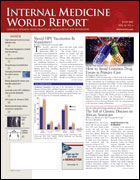Publication
Article
Internal Medicine World Report
HPV Vaccine Only Covers a Minority of Infected Patients
Author(s):
New Prevalence Study: Types 16, 18 Rare in the United States
When the first human papillomavirus (HPV) vaccine was approved last year, it was hailed as the first step in preventing cervical cancer and was expected to save the lives of many women and prevent thousands of cancers. Now the first national estimates of the prevalence of HPV infection have shown that only a small minority of females in the United States are infected with the HPV types included in the current quadrivalent vaccine (Gardasil).
JAMA
The study (. 2007;297:813-819) was conducted to establish the baseline prevalence data needed to measure the eventual effects of widespread HPV vaccination. Investigators analyzed a representative sample of 1921 females (aged 14-59) who participated in the National Health and Nutrition Examination Survey (NHANES) 2003-2004; all provided a self-collected vaginal swab specimen. Polymerase chain reaction testing was used to analyze the swabs for HPV DNA.
The overall prevalence of HPV in the study population was 26.8%. Frequency varied by age-group (Table), increasing each year between the ages of 14 and 24 years, and then declining steadily.
Table. HPV infection prevalence, by age
Age-group, y (n)
Prevalence, %
14-19 (652)
24.5
20-24 (189)
44.8
25-29 (174)
27.4
30-39 (328)
27.5
40-49 (324)
25.2
50-59 (254)
19.6
JAMA
Adapted from Dunne EF, et al. Prevalence of HPV infection among females in the United States. . 2007;297:813-819.
In the 14- to -24-year-old age-group, the prevalence of HPV infection was 33.8%, which translates into 7.5 million females, a number substantially higher than previous estimates of around 4.6 million.
Also in contrast to earlier research that identified HPV 16 as the most common type in infected women, the prevalence of HPV 16 in this study was surprisingly low, and that of type 18 even lower. In fact, the 2 high-risk HPV types included in the quadrivalent vaccine were rarely detected, with only 1.5% of women infected with HPV 16 and only 0.8% with HPV 18.
The prevalence of the 2 low-risk HPV types included in the vaccine was similarly low, with 1.3% infected with HPV 6 and 0.1% with HPV 11. The combined prevalence of all 4 vaccine types was 3.4% of all HPV infections.
Age was not the only variable that factored into the likelihood of being infected with HPV. Among sexually active women (aged 18-59 years), those who were widowed, divorced, separated, or living with a partner were more than 3 times as likely to be infected with HPV than were married women, and never-married women were more than twice as likely to be infected.
As expected, the risk for HPV infection increased with the number of sexual partners. Compared with women who had only 1 sex partner in their life, those with ≥3 lifetime sex partners were almost 3 times as likely to be infected.
In an accompanying editorial, Susan C. Weller, PhD, and Lawrence R. Stanberry, MD, PhD, speculated that the difference in prevalence compared with previous research may reflect the sample studied, since younger women tend to be less likely to participate in NHANES. And although these new data warrant a reevaluation of the cost-effectiveness of the HPV vaccine, Drs Weller and Stanberry doubt that it would change the current view that universal immunization is cost-effective.
Medical and Legal Concerns of Mandating HPV Vaccination
New York Times
On February 11, 2007, the reported that the manufacturer of the human papillomavirus (HPV) quadrivalent vaccine (Gardasil) was actively urging lawmakers to enact legislation to make vaccination mandatory before young girls could enter school. Ten days later, the same newspaper reported that the manufacturer had announced it was ceasing all lobbying efforts. What happened?
The flurry of legislation to make vaccination a prerequisite for attending school provided a lightning rod for critics, including medical experts, who have raised questions about the ethics of mandatory HPV vaccination, as well as the long-term efficacy and safety of the vaccine.
Journal of the American Medical Association
In a recent editorial in the (2007;297:1921-1923), Lawrence O. Gostin, JD, LLD, Georgetown Law Center, Washington, DC, and Catherine D. DeAngelis, MD, MPH, the journal's editor-in-chief, argue that measures to legislate mandatory HPV vaccination have "undermined public confidence and created a backlash among parents." They point out that:
- Limited data support the safety and efficacy of the vaccine (studies have included <12,000 participants and lasted for only 5 years)
- Efficacy in girls aged 9 to 15 years has not yet been evaluated
- The long-term effects of the vaccine are unknown
- HPV is not a very infectious airborne disease that poses an immediate risk of rapid transmission in schools.
Drs Gostin and DeAngelis emphasize that their concerns are not motivated by morals, and there is no evidence that appropriately designed public health programs encourage sexual activity.
But mandating vaccination erodes public confidence and can engender hostility among parents. Since there is no immediate threat of serious harm, voluntary measures should be considered first, and outstanding questions should be answered, including:
- Why force a child to be vaccinated when her lifetime risk of cervical cancer is low?
- How will immunized children be compensated if they experience serious adverse events in the future?
- Why are boys exempted?
- Who will pay for the vaccine?
Legal Status
In February 2007, the governor of Texas signed an executive order to make the quadrivalent vaccine mandatory for girls entering the sixth grade. The Texas state legislature voted to overturn this order, and their bill was sent to the governor, where it awaits his signature.
In March, the Virginia legislature passed a vaccine requirement bill, which was amended by the governor to give parents more "opt-out" rights. The National Conference of State Legislatures (www.ncsl.org) reports that 22 other states and the District of Columbia are currently considering mandated vaccination for school-aged girls (≥11 years).






